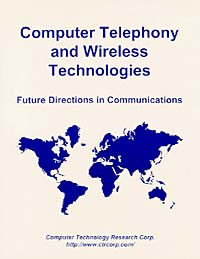This new 275-page report from CTR provides a comprehensive analysis of two of today"s most dynamic areas in information technology: computer telephony (CT) and wireless communications. The report explores how these applications can provide solutions to your organization"s business needs.
Computer Telephony and Wireless Technologies: An Overview
Using the right technology in order to implement new business solutions will often determine the success or failure of the enterprise. CTR"s new report, Computer Telephony and Wireless Technologies: Future Directions in Communications, provides a comprehensive analysis of two of today"s most dynamic areas in information technology (IT): computer telephony (CT) and wireless communications. The report focuses on the business applications of CT and wireless communications and explains the benefits these technologies offer.
CTR"s report provides critical information that will help IT managers understand the latest developments in communications and the impact these developments will have on the enterprise.
Computer Telephony Defined
CT was once defined as the integration of a company"s computer system with its telephone system. While this is still true, today"s complex computing infrastructuresdemand a more precise definition.
CTR"s Computer Telephony and Wireless Technologies: Future Directions in Communications report defines CT as a platform that merges voice and data services in order to enable the development of integrated business applications.
The report describes the functionality of early CT applications and explores the applications that are popular today, including client/server (C/S)-based applications, unified messaging and mobility, call centers, and speech processing.
The report also evaluates the key issues surrounding Internet telephony, faxing over an intranet, and integrating CT with Web sites.
The Need for Wireless Technologies
Wireless technologies create a flexible infrastructure that is easily modified to reflect the ongoing and varying needs of the enterprise. With the number of mobile employees continuing to increase, this flexibility is now more important than ever.
Computer Telephony and Wireless Technologies: Future Directions in Communications explains the various public and private infrastructures that are required to support wireless communications for cellular, broadcasting, fixed point-to-point, and satellite networks.
The report also evaluates the advantages and disadvantages of wireless local area networks (LANs), identifies the wireless applications that address specific business needs, and explores the security issues surrounding mobile telephony.
In addition, the report offers a discussion of the recent convergence ofwireless communications and CT and explains what this will mean for the future. Это и многое другое вы найдете в книге Computer Telephony and Wireless Technologies: Future Directions in Communications (Bob Emmerson, David Greetham)
